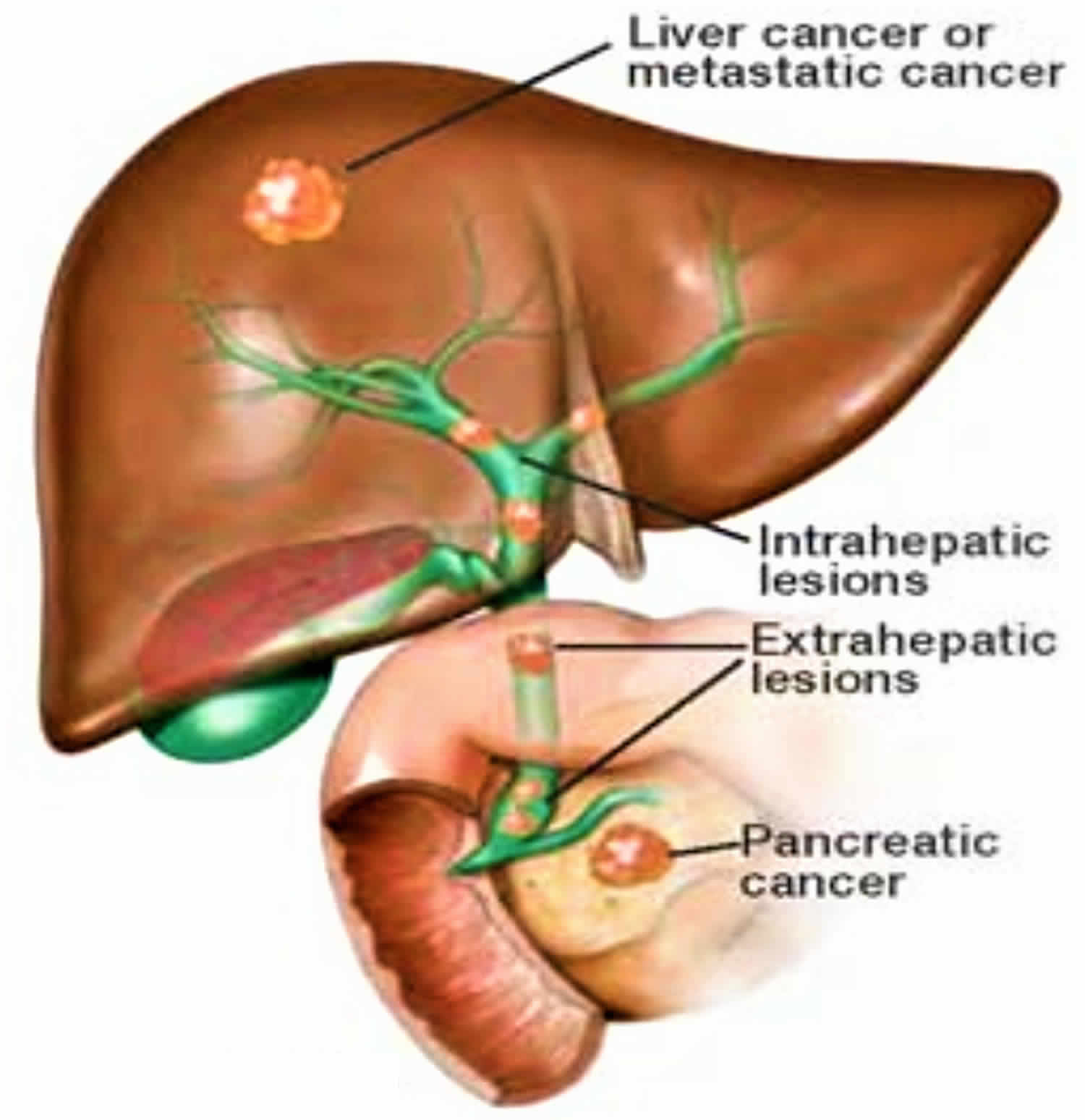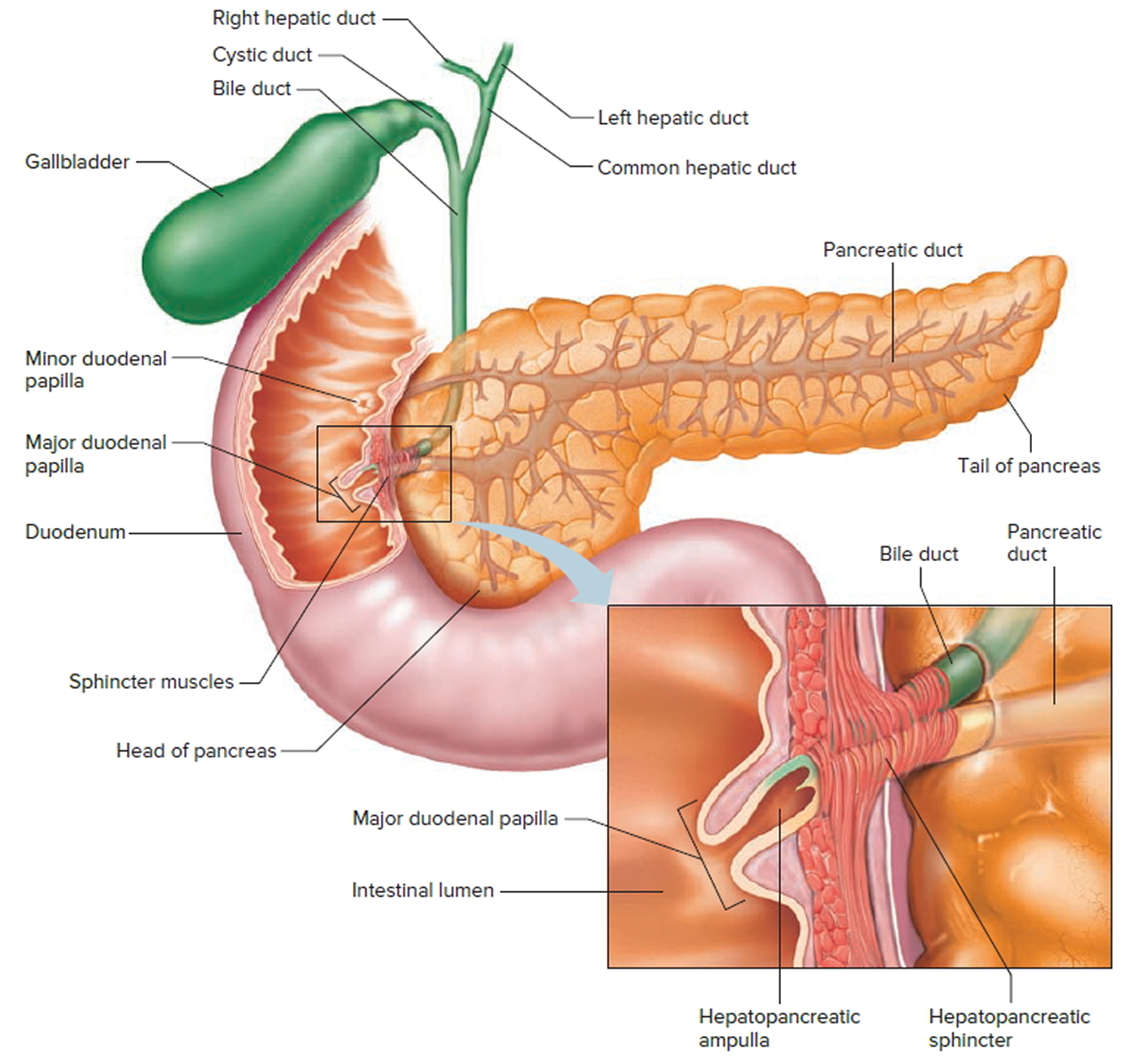Contents
What is a bile duct obstruction
Bile duct obstruction is a blockage in the common bile duct that carry bile from the liver to the gallbladder and small intestine. Bile duct (or biliary) obstruction occurs for numerous reasons. Causes can include cancerous and non-cancerous processes as well as injuries from medical procedures or operations. Obstruction can occur at different levels of the bile duct tree.
Bile is a liquid released by the liver. It contains cholesterol, bile salts, and waste products such as bilirubin. Bile salts help your body break down (digest) fats. Bile passes out of the liver through the bile ducts and is stored in the gallbladder. After a meal, it is released into the small intestine.
When the bile ducts become blocked, bile builds up in the liver, and jaundice (yellow color of the skin) develops due to the increasing level of bilirubin in the blood.
See your doctor if you notice a change in the color of your urine and stools or you develop jaundice.
Figure 1. Location of the human liver
Figure 3. The common bile duct is closely associated with the pancreatic duct and the duodenum
Bile duct obstruction causes
The possible causes of bile duct obstruction include:
- Cysts of the common bile duct
- Enlarged lymph nodes in the porta hepatis
- Gallstones
- Inflammation of the bile ducts
- Narrowing of the bile ducts from scarring
- Injury from gallbladder surgery
- Tumors of the bile ducts or pancreas
- Tumors that have spread to the biliary system
- Liver and bile duct worms (flukes)
Cancerous lesions
The presence of a cancerous lesion(s) within the hepatobiliary system can also lead to bile duct obstruction. In these cases, optimal treatment requires a multimodal approach that includes a surgeon, oncologist and interventionalist (endoscopist and radiologist) and radiation oncologists.
Liver lesions
Cancers of the bile ducts within the liver, liver cancers or cancers metastatic to the liver can cause obstruction of the bile duct system. Diagnosis is usually made by radiographic studies (CT or MRI). Prior to treatment of the obstruction, a full work-up of the lesion to determine the extent of disease is necessary. Additionally, a biopsy of the lesion may be needed, which is usually performed with CT or ultrasound guidance. Imaging of the bile ducts within the liver are obtained via radiologic (PTC or percutaneous transhepatic cholangiography) and/or interventional endoscopic (ERCP) procedures.
Treatment depends on the extent, location and type of cancer. An endoscopic ultrasound may be required to determine the extent of disease. Interventional approaches can be used to treat the obstruction if the patient is not a surgical candidate.
Extrahepatic bile duct cancers
An extrahepatic bile duct cancer refers to all cancers that arise within the bile duct system below the liver. Diagnosis is usually made by radiological imaging. Further elucidation with endoscopic retrograde cholangiopancreatography (ERCP), percutaneous transhepatic cholangiography and endoscopic ultrasound may be required. Brushings and subsequent pathological examination of the bile duct help with the diagnosis. Surgical versus interventional approaches are assessed on a patient-by-patient basis.
Pancreatic cancers
Pancreatic cancers can cause obstruction of the bile duct just as it enters the intestine. Diagnosis is usually made radiographically. Treatment of this patient requires a multidisciplinary approach encompassing surgeons, oncologists, radiologists and radiation oncologists for an optimal outcome.
Iatrogenic
Biliary stricturing (narrowing) or obstruction may be the result of an injury sustained during a medical procedure. For example, a gallbladder operation or endoscopic procedure can cause a bile duct injury or transection. Surgeons usually treat a bile duct transection at time of injury if noticed. Bile duct injuries that do not cause bile spillage but cause strictures are usually treated when symptoms arise. Patients often have pain, fever and/or jaundice, as well as elevation in liver laboratory tests. Operative treatment is usually required.
Cholelithiasis (gallstones) and biliary stones (choledocholithiasis)
Gallstones or biliary stones can pass from the gallbladder or liver, respectively, into the common bile duct and proceed into the small intestine depending on their size. As they pass through the biliary tree, these stones may cause obstructions if they are lodged in the bile duct. Additionally, strictures may occur due to repeated trauma to the bile duct lining. Interventional endoscopists can extract lodged stones in the common bile duct tree by performing a procedure called an ERCP (endoscopic retrograde cholangiopancreatography). Similarly, strictures can be treated by an interventional endoscopist or interventional radiologist, depending on the site of the problem and issues related to the patient’s surgical candidacy. After stone removal, further operations may be necessary to remove the source of the stones (gallbladder or part of the liver).
Biliary leaks result when bile extravasates (leaks) through defects in the bile duct wall. This leakage can occur anywhere within the bile duct system. Most commonly, biliary leaks are the result of medical procedures, operations, or traumatic injuries to the biliary system. The end result is bile leakage into the abdomen or surrounding tissues. Interventional approaches (interventional radiologic procedures and interventional endoscopic procedures) are able to treat a majority of the injuries. Surgery may be needed in some situations.
Risk factors for bile duct obstruction
The risk factors for bile duct obstruction include:
- History of gallstones, chronic pancreatitis, or pancreatic cancer
- Injury to the abdominal area
- Recent biliary surgery
- Recent biliary cancer (such as bile duct cancer)
The blockage can also be caused by infections. This is more common in people with weakened immune systems.
Bile duct obstruction prevention
Be aware of any risk factors you have, so that you can get prompt diagnosis and treatment if a bile duct becomes blocked. The blockage itself may not be preventable.
Bile duct obstruction signs and symptoms
Symptoms of bile duct obstruction may include:
- Abdominal pain in the upper right side
- Dark urine
- Fever
- Itching
- Jaundice (yellow skin color)
- Nausea and vomiting
- Pale-colored stools
Bile duct obstruction possible complications
Left untreated, the possible complications include infections, sepsis, and liver disease, such as biliary cirrhosis.
Bile duct obstruction diagnosis
Your health care provider will examine you and feel your belly.
The following blood test results could be due to a possible blockage:
- Increased bilirubin level
- Increased alkaline phosphatase level
- Increased liver enzymes
The following tests may be used to investigate a possible blocked bile duct:
- Abdominal ultrasound
- Abdominal CT scan
- Endoscopic retrograde cholangiopancreatography (ERCP)
- Percutaneous transhepatic cholangiogram (PTCA)
- Magnetic resonance cholangiopancreatography (MRCP)
- Endoscopic ultrasound (EUS)
A blocked bile duct may also alter the results of the following tests:
- Amylase blood test
- Gallbladder radionuclide scan
- Lipase blood test
- Prothrombin time (PT)
- Urine bilirubin
Bile duct obstruction treatment
The goal of treatment is to relieve the bile duct obstruction. Stones may be removed using an endoscope during an ERCP (endoscopic retrograde cholangiopancreatography).
In some cases, surgery is required to bypass the blockage. The gallbladder will usually be surgically removed if the blockage is caused by gallstones. Your provider may prescribe antibiotics to treat a bile duct infection if an infection is suspected.
If the blockage is caused by cancer, the duct may need to be widened. This procedure is called endoscopic or percutaneous (through the skin next to the liver) dilation. A tube may need to be placed to allow drainage.
Itchy skin
Your doctor may recommend over-the-counter products and medicines or prescribe medicines to treat itchy skin. Over-the-counter products and medicines include:
- skin creams and lotions that contain camphor, menthol , pramoxine , or capsaicin
- antihistamines such as fexofenadine
For mild itchy skin, your doctor may prescribe hydroxyzine . For severe itchy skin, your doctor may prescribe cholestyramine.
Low levels of fat-soluble vitamins in your body
If you have low levels of fat-soluble vitamins in your body, your doctor may recommend dietary supplements of vitamins A, D, E, and K. Follow your doctor’s instructions on the type and amount of vitamins you should take.
Bile duct obstruction surgery
Individuals with cancerous lesions need a multidisciplinary approach from the onset of their work-up. Interventional approaches are used to help diagnose the lesions. Once diagnosed, optimal management is discussed with surgeons, interventionalists and oncologists. If the patient is deemed a surgical candidate, physicians pursue resection of the lesion followed by biliary reconstruction. These operations depend on the location of the lesion causing the obstruction (liver, bile duct, and/or pancreas). Interventional approaches are usually used in cases in which the patient is not a surgical candidate and the risk of the operation is outweighed by the benefits afforded by surgical intervention.
The mainstay of surgical treatment is to first remove the area of stricture, then reconstruct the biliary system. The most common operation is a Roux-en-Y reconstruction. The Roux limb is connected to the remnant bile duct outside of the liver (Roux-en-Y choledochojejunostomy) or the bile ducts within the liver (Roux-en-Y hepaticojejunostomy). All procedures require close oncological follow-up.
Bile duct obstruction prognosis
If the blockage is not corrected, it can lead to life-threatening infection and a dangerous buildup of bilirubin.
If the blockage lasts a long time, chronic liver disease can result. Most obstructions can be treated with endoscopy or surgery. Obstructions caused by cancer often have a worse outcome.








